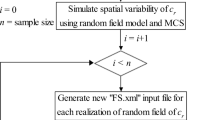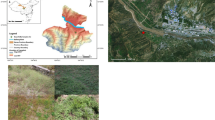Abstract
Forests can prevent and/or mitigate hydrogeomorphic hazards in mountainous landscapes. Their effect is particularly relevant in the case of shallow landslides phenomena, where plants decrease the water content of the soil and increase its mechanical strength. Although such an effect is well known, its quantification is a relatively new challenge. The present work estimates the effect of some forest species on hillslope stability in terms of additional root cohesion by means of a model based on the classical Wu and Waldron approach (Wu in Alaska Geotech Rpt No 5 Dpt Civ Eng Ohio State Univ Columbus, USA, 1976; Waldron in Soil Sci Soc Am J 41:843–849, 1977). The model is able to account for root distribution with depth and non-simultaneous root breaking. Samples of European beech (Fagus sylvatica L.), Norway spruce (Picea abies (L.) Karst.), European larch (Larix decidua Mill.), sweet chestnut (Castanea sativa Mill.) and European hop-hornbeam (Ostrya carpinifolia Scop.), were taken from different locations of Lombardy (Northern Italy) to estimate root tensile strength, the Root Area Ratio and the root cohesion distribution in the soil. The results show that, in spite of its dramatic variability within the same species at the same location and among different locations, root cohesion can be coherently interpreted using the proposed method. The values herein obtained are significant for slope stabilisation, are consistent with the results of direct shear tests and back-analysis data, and can be used for the estimation of the stability of forested hillslopes in the Alps.












Similar content being viewed by others
References
Abe K, Iawamoto M (1986) An evaluation of tree-root effect on slope stability by tree-root strength. J Jpn For Soc 68:505–510
Abe K, Ziemer RR (1991) Effect of tree roots on a shear zone: modeling reinforced shear stress. Can J Res 21:1012–1019 doi:10.1139/x91-139
Abernethy B, Rutherfurd ID (2001) The distribution and strength of riparian tree roots in relation to riverbank reinforcement. Hydrol Process 15:63–79 doi:10.1002/hyp.152
Babu J, Herendra NP, Radhey ST (2001) Vertical distribution and seasonal changes of fine and coarse root mass in Pinus kesiya Royle Ex.Gordon forest of three different ages. Acta Oecol 22:293–300 doi:10.1016/S1146-609X(01)01118-3
Bischetti GB, Bonfanti F, Greppi M (2003) Misura della resistenza alla trazione delle radici: apparato sperimentale e metodologia d’analisi. Quad Idronomia Mont 241(1) (in Italian)
Bischetti GB, Chiaradia EA, Simonato T et al (2005) Root strength and root area ratio of forest species in Lombardy (Northern Italy). Plant Soil 278:11–22 doi:10.1007/s11104-005-0605-4
Burke MK, Raynal DJ (1994) Fine root growth phenology, production and turnover in a northern hardwood forest ecosystem. Plant Soil 162:135–146 doi:10.1007/BF01416099
Burroughs ER, Thomas BR (1977) Declining root strength in Douglas-fir after felling as a factor in slope stability. USDA For Serv Res Pap INT-190, 27 pp
Büttner V, Leuschner C (1994) Spatial and temporal patterns of fine root abundance in a mixed oak beech forest. For Ecol Manag 70:11–21
Daniels HE (1945) The statistical theory of the strength of bundles of threads. Proc R Soc Lond A Math Phys Sci 183:405 doi:10.1098/rspa.1945.0011
Danjon F, Barker DH, Drexhage M, Stokes A (2008) Using 3D plant root architecture in models of shallow slope stability. Ann Bot (Lond) 101:1281–1293 doi:10.1093/aob/mcm199
Day RW (2001) Soil Testing Manual: Procedures, Classification Data, and Sampling Practices. McGraw-Hill Professional
De Baets S, Poesen J, Reubens B et al (2008) Root tensile strength and root distribution of typical Mediterranean plant species and their contribution to soil shear strength. Plant Soil 305:207–226
Docker BB, Hubble TCT (2008) Quantifying root-reinforcement of river bank soils by four Australian tree species. Geomorphol doi:10.1016/j.geomorph.2008.01.009
Ekanayake JC, Phillips CJ (1999) A method for stability analysis of vegetated hillslopes: an energy approach. Can Geotech J 36:1172–1184 doi:10.1139/cgj-36-6-1172
Endo T, Tsuruta T (1969) Effect of trees’ roots upon the shearing strength of soil. 18th Annual Rpt of the Okkaido Branch. For Exp Stn, Tokio, Japan, 167–169
Frydman S, Operstein V (2001) Numerical simulation of direct shear of root-reinforced soil. Ground Improv 5:41–48 doi:10.1680/grim.5.1.41.39437
Genet M, Stokes A, Salin F et al (2005) The influence of cellulose content on tensile strength in tree roots. Plant Soil 278:1–9 doi:10.1007/s11104-005-8768-6
Genet M, Stokes A, Fourcaud T et al (2006) Effect of altitude on root mechanical and chemical properties of Abies georgei in Tibet, 5th Plant Biomech Conf—Stockholm, August 28–September 1 2006
Gray DH, Laiser AJ (1982) Biotechnical slope protection and erosion control. Van Nostrand Reinhold, New York. USA
Gray DH, Sotir RB (1996) Biotechnical Soil Bioengineering Slope Stabilization: A Practical Guide for Erosion Control. Wiley, New York, USA
Greenwood JR (2006) SLIP4EX—a program for routine slope stability analysis to include the effects of vegetation, reinforcement and hydrological changes. Geotech Geol Eng 24:193–202
Hammond C, Hall D, Miller S, Swetik P (1992) Level I, stability analysis (LISA) documentation for version 2.0. General Technical Report INT-285. USDA For Serv Intermt Res Stn
Hathaway RL, Penny D (1975) Root strength in some Populus and Salix clones. NZ J Bot 13:333–343
Hemmer PC, Hansen A, Pradhan S (2007) Rupture processes in Fiber Bundle Models. In: Bhattacharyya P, Chakrabarti BK (eds) Modeling Critical and Catastrophic Phenomena in Geoscience, Lecture Notes in Physics No. 705. Springer, Berlin, pp 27–55
Hendriks CMA, Bianchi FJJA (1995) Root density and root biomass in pure and mixed forest stands of Douglas-fir and Beech. Neth J Agric Sci 43:321–331
Keim RF, Skaugset AE (2003) Modelling the effect of forest canopies on slope stability. Hydrol Process 17:1457–1467 doi:10.1002/hyp.5121
Kun F, Raischel F, Hidalgo RC, Herrmann HJ (2007) Extension of Fiber Bundle Models. In: Bhattacharyya P, Chakrabarti BK (eds) Modeling Critical and Catastrophic Phenomena. in Geoscience, Lecture Notes in Physics No. 705. Springer, Berlin, pp 57–92
Lopez-Zamora I, Falcão N, Comerford NB, Barros NF (2002) Root isotropy and an evaluation of a method for measuring root distribution in soil trenches. For Ecol Man 166:303–310
Meyer FH, Göttsche D (1971) Distribution of root tips and tender roots of beech. In: Ellenberg H (ed) Ecological studies. Analysis and synthesis, vol. 2. Springer-Verlag, Berlin, pp 47–52
Morgan RPC, Rickson RJ (1995) Slope stabilization and erosion control—a bioengineering approach. Chapman & Hall, Univ Press, Cambridge, pp 221–264
Nilaweera NS, Nutalaya P (1999) Role of tree roots in slope stabilisation. Bull Eng Geol Environ 57:337–342 doi:10.1007/s100640050056
Normaniza OH, Faisal A, Barakbah SS (2008) Engineering properties of Leucaena leucocephala for prevention of slope failure. Ecol Eng 32:215–221 doi:10.1016/j.ecoleng.2007.11.004
Norris JE (2005) Root reinforcement by hawthorn and oak roots on a highway cut-slope in Southern England. Plant Soil 278:43–53 doi:10.1007/s11104-005-1301-0
Norris JE, Stokes A, Mickowski SB et al (2008a) Slope Stability and Erosion Control: Ecotechnological Solutions, Springer
Norris JE, Greenwood JR, Achim A et al (2008b) Hazard assessment of vegetated slopes. In Norris JE et al (ed) Slope stability and erosion control: Ecotechnological solutions. Springer, 119–166
Operstein V, Frydman S (2000) The influence of vegetation on soil strength. Ground Improv 4:81–89
Pollen N, Simon A (2005) Estimating the mechanical effects of riparian vegetation on streambank stability using a fiber bundle model. Water Resour Res 41:W07025 doi:10.1029/2004WR003801
Reubens B, Poesen J, Danjon F et al (2007) The role of fine and coarse roots in shallow slope stability and soil erosion control with a focus on root system architecture: a review. Trees (Berl) 21:385–402 doi:10.1007/s00468-007-0132-4
Raischel F, Kun F, Herrmann HJ (2008) Continuous damage fiber bundle model for strongly disordered materials. Phys Rev E Stat Nonlin Soft Matter Phys 77:046102 doi:10.1103/PhysRevE.77.046102
Riestenberg MM (1994) Anchoring of thin collovium by roots of sugar maple and with ash on hillslopes in Cincinnati. US Geol Surv Bull 2059-E
Riestenberg MM, Sovonik-Dunford S (1983) The role of woody vegetation in stabilizing slopes in the Cincinnati area Ohio. Geol Soc Am Bull 94:506–518 doi:10.1130/0016-7606(1983)94<506:TROWVI>2.0.CO;2
Roering JJ, Schmidt KM, Stock JD et al (2003) Shallow landsliding, root reinforcement, and the spatial distribution of trees in the Oregon Coast Range. Can Geotech J 40:237–253 doi:10.1139/t02-113
Sakals ME, Sidle RC (2004) A spatial and temporal model of root cohesion in forest soils. Can J Res 34:950–958 doi:10.1139/x03-268
Schiechtl HM (1958) Grundlagen der Grunverbauung. Mitteilungen der Forstlichen bundes-versuchsanstalt Mariabrunn. 55 Heft. 273 pp. (in German)
Schiechtl HM (1980) Bioengineering for land reclamation and conservation. Univ of Alberta Press, Edmonton, Canada
Schmid I, Kazda M (2001) Vertical distribution and radial growth of coarse roots in pure and mixed stands of Fagus sylvatica and Picea abies. Can J Res 31:539–548 doi:10.1139/cjfr-31-3-539
Schmid I, Kazda M (2002) Root distribution of Norway spruce in monospecific and mixed stands on different soils. For Ecol Man 159:37–47
Schmidt KM, Roering JJ, Stock JD et al (2001) The variability of root cohesion as an influence on shallow landslide susceptibility in the Oregon Coast Range. Can Geotech J 38:995–1024 doi:10.1139/cgj-38-5-995
Sidle RC, Ochiai H (2006) Landslides, Processes, Prediction, and Land Use Water Resour Monograph 18, AGU, Washington D.C., USA
Stokes A, Norris JE van Beck LPH et al (2008) How vegetation reinforces the soil on slopes. In Norris JE et al (eds) Slope stability and erosion control: Ecotechnological solutions. Springer, pp 65–118
Sun HL, Li SH, Xiong WL et al (2008) Influence of slope on root system anchorage of Pinus yunnanensis. Ecol Eng 32:60–67 doi:10.1016/j.ecoleng.2007.09.002
Terwillinger VJ, Waldron LJ (1991) Effects of root reinforcement on soil-slip patterns in the Transverse Ranges of southern California. Geol Soc Am Bull 103:775–785 doi:10.1130/0016-7606(1991)103<0775:EORROS>2.3.CO;2
Tosi M (2007) Root tensile strength relationships and their slope stability implications of three shrub species in the Northern Apennines (Italy). Geomorph 87:268–283 doi:10.1016/j.geomorph.2006.09.019
van Beek LP, Wint H, Cammeraat LH, Edwards JP (2005) Observation and simulation of root reinforcement on abandoned Mediterranean slopes. Plant Soil 278:55–74 doi:10.1007/s11104-005-7247-4
Vinceti B, Paoletti E, Wolf U (1998) Analysis of soil, roots and mycorrhizae in a Norway spruce declining forest. Chemospere 36:937–942 doi:10.1016/S0045-6535(97)10151-5
Vogt KA, Persson H (1991) Measuring growth and development of roots. Techniques and approaches in forest tree ecophysiology. CRC, Boca Raton
Waldron LJ (1977) The shear resistance of root-permeated homogeneous and stratified soil. Soil Sci Soc Am J 41:843–849
Waldron LJ, Dakessian S (1981) Soil reinforcement by roots: calculation of increased soil shear resistance from root properties. Soil Sci 132:427–435 doi:10.1097/00010694-198112000-00007
Wu TH (1976) Investigation on landslides on Prince of Wales Island. Alaska Geotech Rpt No 5 Dpt Civ Eng Ohio State Univ Columbus, USA
Wu TH (1995) Slope Stabilization. In: Morgan RPC, Rickson RJ (eds) Slope Stabilization and Erosion Control-A Bioengineering Approach. Chapman & Hall, Univ Press, Cambridge, pp 221–264
Wu TH, McKinnell WP III, Swanston DN (1979) Strength of tree roots and landslides on Prince of Wales Island, Alaska. Can Geotech J 16:19–33
Wu TH, Beal PE, Lan C (1988) In-situ shear tests of soil-root system. J Geotech Eng ASCE 114:1376–1394 doi:10.1061/(ASCE)0733-9410(1988)114:12(1376)
Xu YJ, Röhrig E, Fölster H (1997) Reaction of root systems of grand fir (Abies grandis Lindl.) and Norway spruce (Picea abies Karst.) to seasonal waterlogging. For Ecol Man 93:9–19
Yazici B, Yolacan S (2007) A comparison of various tests of normality. J Stat Comput Simul 77:75–183 doi:10.1080/10629360600678310
Ziemer RR (1981) Roots and stability of forested slopes. In Davies TRH, Pearce AJ (eds) Erosion and sediment transport in Pacific Rim steeplands. Int Assoc Hydrol Sci Pub 132:343–361
Acknowledgements
The research activity is part of the Research Program SISIFO funded by Regione Lombardia—Agricultural Directorate. The Authors wish to thank Dr. Giulio Zanetti for the field support, Dr. Eric Spelta for helping in some data elaboration, Prof. Claudio Gandolfi for the profitable discussions and the two anonymous reviewers for their helpful suggestions.
Author information
Authors and Affiliations
Corresponding author
Additional information
Responsible Editor: Lars S. Jensen.
Rights and permissions
About this article
Cite this article
Bischetti, G.B., Chiaradia, E.A., Epis, T. et al. Root cohesion of forest species in the Italian Alps. Plant Soil 324, 71–89 (2009). https://doi.org/10.1007/s11104-009-9941-0
Received:
Accepted:
Published:
Issue Date:
DOI: https://doi.org/10.1007/s11104-009-9941-0




